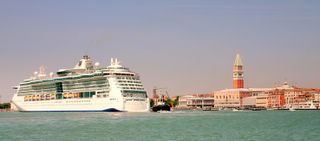By TOBY STERLING, Associated Press Writer
AMSTERDAM, Netherlands (AP) - The disaster came in 1953.
A powerful storm breached sea dikes in the south of the Netherlands, killing more than 1,800 people and cementing a deep resolve among the Dutch that their ancient enemy--water--would never kill again.
So the government launched a massive project to upgrade its ancient system of dikes and dunes. The crown jewel, a chain of 40-foot-tall steel walls suspended by piers in the open sea, was completed in the 1980s and cost today's equivalent of $3.1 billion. It is considered among the world's best defenses against flooding.
Also-vulnerable Venice, Italy, is putting a similar system in place. But the deluge in New Orleans has prompted Europeans to wonder if their sophisticated protections-- or any--will ever be enough.
For the waterlogged Netherlands, whose very name means "the low-lying country," the worst-case scenario would be far more devastating than Hurricane Katrina, entailing a tidal wave strong enough to penetrate the nation's coastal barriers.
The chance of such a disaster is seen as remote. But floods have happened many times in Dutch history, and no one doubts one could happen again--under the right conditions.
"Rationally, you know it can happen, but you pray it never does," said Peter Dolen, the head of the Interior Ministry's Risk and Crisis Communication Center. "You can draw up any plan you like from behind your desk, but you know it's going to be different in reality."
Nearly half the Netherlands is under sea level, and two-thirds of its 16 million population lives in those areas. Even Amsterdam's famous canals lie more than six feet below the sea. Yet evacuation is a last resort. Written into Dutch law is the requirement that the coastal dikes be able to withstand the fiercest storm imaginable.
"It would come in the winter, at high tide on a new moon," said Henk van der Brink of the Royal Dutch Weather Institute, whose models are used by the country's dike engineers. "Two big storms would join together to form a single storm of a much greater magnitude--the 'perfect storm.'"
A similar confluence last happened on Feb. 1, 1953, with gale-force northwesterly winds, a sudden squall and an unusually high tide. The sea rushed into the Dutch countryside, resulting in the flood known here simply as "`the disaster."
"It was so sudden it caught everyone completely by surprise. There was no time to prepare," says researcher Toon Franken of the Zeeland Archives in the city of Middelburg, where the disaster hit hardest.
In Venice, the last big flood was on Nov. 4, 1966, when sea waters rose nearly six feet above normal. Some 3,000 people were evacuated.
Aiming for better defenses, Italy launched its $4 billion "Moses" project, named for the biblical figure who parted the Red Sea. It envisions hinged barriers built on the Adriatic seabed that would rise when high tides threaten the city, said Monica Ambrosini at the New Venice Consortium, the agency overseeing the project. Completion is expected by 2010-2011.
"We're not protected from an extraordinary event," Ambrosini said. "Let's hope that it does not arrive before we finish."
Venetians themselves are more relaxed. They already live with constant minor flooding, thanks to the notorious "acqua alta," or high tide. Tourists and residents alike don rubber boots when canals spill over onto the cobblestones.
As in Amsterdam, sirens in Venice should warn people of impending disaster well in advance. Plus, the area is not prone to the hurricanes that regularly pummel the United States or cataclysmic tsunami like the one that hit Asia in December.
"I am astounded by the images of New Orleans. This is something you cannot and will not see here," said Paolo Canestrelli, director of Venice's tidal forecast center.
Today, the Netherlands is spending $3.7 billion on new projects, in addition to $620 million spent annually on maintaining the current system, farmed out to engineering firms like Boskalis NV and BAM Group NV.
One construction company, Dura Vermeer, has made a profitable business out of building houses that float.
The latest defense plan, "Living with Water," involves working with the forces of nature. Engineers dump sand onto beaches or just offshore in areas deemed most vulnerable, harnessing the natural power of waves to mold the sand over time into new, protective dunes. The technique is gradually replacing the coastal dikes the Dutch have been building since 500 B.C.
River flooding is seen as a less catastrophic but more likely danger. The Rhine and Maas, which flooded twice in the 1990s, are being broadened in spots. Rather than raising the banks against overflow, buildings are being cleared to make "room for the river."
Plans also are in place to bulldoze holes in some dikes during emergencies to flood sparsely populated farmland and lessen dangers elsewhere.
"Water can be a nice friend sometimes, but will always remain an enemy," said Willem Nuis, mayor of Tholen, a town of 24,000 where the 1953 flood killed 166 people. "For us, it was the worst thing that happened here since the Middle Ages."
---
Associated Press writers Frances D'Emilio in Venice and Aidan Lewis and Ariel David in Rome contributed to this story.
From http://www.guardian.co.uk/worldlatest/story/0,1280,-5249188,00.html



